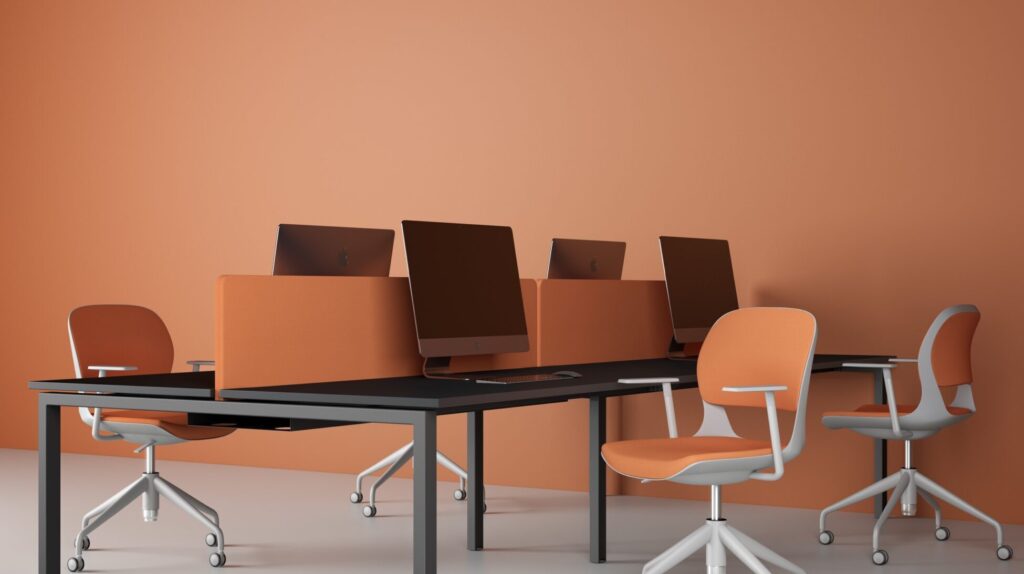Office design encompasses various elements that impact employee well-being and productivity, and one of the most influential factors is colour. The field of colour psychology explores the profound effects that different colours have on human emotions, moods, and behaviours.
Understanding the role of colour psychology in office design allows businesses to create workspaces that evoke the desired atmosphere, enhance employee engagement, and promote overall workplace satisfaction. Our team at Nolan Interiors have a real fascination for colour psychology and its application in office design. When helping to redesign your office we will always highlight the effects of different colours on employees’ psychological well-being and offer practical insights for creating harmonious and inspiring work environments.
Warm colours in your office environment
Warm colours such as red, orange, and yellow are known to stimulate energy, creativity, and enthusiasm. These colours can be strategically incorporated into office design to create a vibrant and lively atmosphere. Red, for example, is associated with passion and can be used in accent walls or furniture to stimulate productivity and evoke a sense of urgency. Orange promotes optimism and social interaction, making it suitable for collaborative spaces or common areas. Yellow is known to enhance focus and stimulate mental agility, making it a good choice for areas where concentration and creativity are essential, such as brainstorming rooms or design studios.
Calming and cool colours in the office
Cool colours, including blue, green, and purple, have a calming and soothing impact on individuals. Blue is often associated with feelings of tranquillity and trust, making it ideal for workspaces that require focus and concentration, such as offices or conference rooms. Green represents harmony and balance, evoking a sense of renewal and promoting a connection with nature. Integrating green elements, such as indoor plants or green accent walls, can create a refreshing and relaxing environment. There is a lot of work into the study of bringing the outdoors in and how this method can help to increase employee productivity in the workplace. Purple, with its association with creativity and introspection, can be used sparingly to add a touch of inspiration and luxury to specific areas, such as creative studios or executive offices.
Neutral office colours
Neutral colours, such as grey, beige, and white, form the foundation of many office designs due to their versatility and timeless appeal. These colours provide a backdrop that allows other elements in the office to stand out while promoting a sense of professionalism and sophistication. Grey, in particular, is associated with stability and balance, making it a popular choice for modern office designs. Beige and white create an open and airy ambiance, providing a sense of cleanliness and spaciousness. When combined with pops of colour through furniture, artwork, or accessories, neutral tones can create a visually appealing and adaptable workspace.
Add accent colours to your office design
Incorporating accent colours strategically can add visual interest and create focal points within an office space. Accent colours should complement the overall colour scheme while conveying the desired emotional impact. Bright and bold accents, such as energetic red or vibrant yellow, can be used sparingly to draw attention to specific areas or elements. Subtle accent colours, such as soft pastels or muted tones, can add a touch of sophistication and harmony. Our Nolans top tip would be to carefully select accent colours and apply them to feature walls, furniture, or decorative elements. Businesses can create a visually stimulating environment that aligns with their brand identity and evokes the desired emotional response from employees by employing the right accent colours.
Understand colour psychology
Colour psychology plays a significant role in office design, as different colours have the power to influence emotions, moods, and behaviours. By leveraging the principles of colour psychology, businesses can create office spaces that foster the desired atmosphere, enhance employee engagement, and promote overall well-being. Whether it’s incorporating warm colours to stimulate energy and creativity, using cool colours to create a calming and focused environment. Utilising neutral tones for versatility, or incorporating accent colours for visual interest, thoughtful colour choices can transform the office into a space that inspires productivity, creativity, and positivity. By understanding the impact of colour on psychology and considering the cultural context, organisations can harness the power of colour to create harmonious and inspiring work environments that benefit both employees and the overall success of the business.


